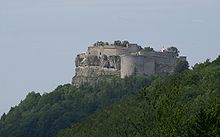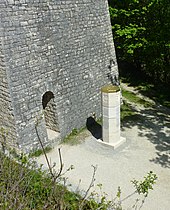Hohenneuffen Castle
| Hohenneuffen Castle | ||
|---|---|---|
|
Hohenneuffen castle ruins |
||
| Creation time : | 1100-1120 | |
| Castle type : | Hilltop castle | |
| Conservation status: | ruin | |
| Place: | Neuffen | |
| Geographical location | 48 ° 33 '20 " N , 9 ° 23' 33" E | |
| Height: | 745.4 m above sea level NHN | |
|
|
||
The Hohenneuffen Castle is the ruins of a large hill fort above the town of Neuffen in the district of Esslingen in Baden-Württemberg .
Geographical location
The high medieval castle ruins are located east of Neuffen at 745.4 m above sea level. NHN high fortress mountain , a white Jurassic rock on the edge of the Swabian Alb . This represents a strategically favorable location on the Albtrauf .
history
The Hohenneuffen was already settled in ancient times. In the late Celtic La Tène period (450 to 1 BC) he formed an outpost of the well-known Heidengraben - oppidum , which included the entire "Erkenbrechtsweiler peninsula" of the Swabian Alb.
The origin of the name (1206 Niffen ) is controversial. On the one hand, it is traced back to a Celtic word * Nîpen and then interpreted as a " battle castle ". Another etymology derives the name from Germanic * hnîpa with the meaning "steep slope, mountain slope".
The castle was built between 1100 and 1120 by Mangold von Sulmetingen , who later called himself von Neuffen . It was first mentioned in a document in 1198, at that time owned by the Noble Free von Neuffen , to which the minstrel Gottfried von Neifen belonged. At the end of the 13th century the castle went to the Lords of Weinsberg , who sold it to the House of Württemberg in 1301 . The castle proved its ability to defend itself in the internal conflicts of the Holy Roman Empire (the Imperial War ), in which it could not be taken in 1312.
The expansion of the Hohenneuffen into a state fortress began as early as the 15th century. The decisive building measures for the fortified complex were not undertaken by Duke Ulrich until the middle of the 16th century . The outworks , round towers, bastions , a commandant's office , casemates , stables , the armory and two cisterns were built . The fortification thus created existed for two centuries without any major changes. In 1519 she had to surrender to the Swabian Federation . In the German Peasant Wars from 1524 it could not be taken again.


The Hohenneuffen was besieged for more than a year during the Thirty Years War . In November, the fortress commander, Captain Johann Philipp Schnurm, and the troubled crew decided to negotiate a surrender with the enemy, which provided for a free withdrawal with weapons and all belongings. On November 22nd, 1635, Schnurm handed the fortress over to the imperial troops after a 15-month siege. Contrary to the promises, the team was forced to serve in the imperial army, and Schnurm lost his property.
A legend, which does not correspond to the historical events, says the following: The people at the castle gave their donkey the last grain that they had left, slaughtered it and threw the filled stomach of the animal into the camp of the enemy. Because they believed that the besieged still had enough supplies, they lost patience and moved away. Since then, the donkey has been the “mascot” of the city of Neuffen.
The Württemberg Duke Karl Alexander wanted to develop the Hohenneuffen into a fortress based on the French model in the 18th century; but he died before completion, his successor Carl Eugen soon abandoned the plan in view of the high costs and dubious military benefits. 1793 was razing the fortress and the sale of building materials approved. From 1795 it was no longer used and finally released for demolition in 1801. This started two years later. The residents of the area were happy about the cheap building material. It was not until 1830 that they began to secure the remains, and in the 1860s the ruins were made accessible. In 1862 a restaurant was set up in the building in the upper courtyard.

Like other fortresses, the Hohenneuffen always served as a state prison, where important prisoners were held and, if necessary, tortured. The fates of some are known. A young Count von Helfenstein, Friedrich, fell to his death in 1502 while attempting to escape. In 1512 Duke Ulrich had the abbot of the Zwiefalten monastery, Georg Fischer, detained here. The elderly Tübingen Vogt Konrad Breuning was also subjected to the prince's arbitrariness in 1517 and was beheaded after imprisonment and torture in Stuttgart. In the 17th century, Matthäus Enzlin , Duke Friedrich's chancellor , suffered a similar fate. In 1737 Joseph Suss Oppenheimer , the Jewish court factor and personal financial advisor to Duke Karl Alexander, was incarcerated for a few weeks on the Hohenneuffen before he was transferred to the Hohenasperg fortress and executed in 1738 as a victim of a judicial murder at the gates of Stuttgart.
During the Second World War , the Hohenneuffen was an air station .
The three-country conference
The military governments of the zones of occupation founded the states of Württemberg-Baden in the American zone in 1945/46 and Württemberg-Hohenzollern and Baden (so called, although it only included the southern part of the country) in the French zone. When it became clear in 1948 that a constitution was being drawn up for western Germany, some politicians took the initiative, they wanted the countries in the south-west to merge. The head of government of Württemberg-Baden, Reinhold Maier , invited the governments of the three countries to a conference on August 2, 1948 on the Hohenneuffen. He wanted to make a first approximation. A delegation led by Leo Wohleb , who was an uncompromising advocate for the restoration of the state of Baden, took part in southern Baden. Württemberg-Hohenzollern was represented by its Minister of the Interior, Viktor Renner . In the delegations were ministers, party leaders, members of parliament and officials from the three countries.
The venue was chosen with care. The wide view of the country and, above all, the drastic zone boundary between the districts of Reutlingen and Nürtingen a few kilometers away should be impressive. Secluded from their governments and the public, the participants wanted to debate factually, well served with valley wine . An agreement was not reached in the end, but the meeting had given impetus and important foundations were set. This three-country conference on the Hohenneuffen thus marks the beginning of the long-term dispute about the formation of the south-western state of Baden-Württemberg , which was launched in 1952.
On the occasion of the 60th anniversary of this conference, the district administrator of the Esslingen district , Heinz Eininger , handed over an information board for the three-country conference in 1948 on October 6, 2008 , which was installed in the historic conference room.
Todays use
Today the Hohenneuffen with its restaurant, beer garden and kiosk is a popular destination. Entry to the castle is free. The casemates, some of which are accessible, are worth seeing .
Every year in June the Hohenneuffen mountain run takes place, in which the runners cover a distance of 9.3 km and 438 meters of altitude from the start in Linsenhofen. The organizers of the mountain run are TSV Beuren and TSV Frickenhausen . Many other events take place at the castle, such as a medieval market or concerts in the castle courtyard. In the summer season, a “falconry spectacle” takes place here on Sundays and public holidays, where many birds of prey are shown in free flight. From April to October, on the 2nd Sunday of the month, the Church in the Green takes place.
The lighting of the outer walls on Sundays and public holidays is also very impressive. The facility, originally donated by the Neuffen citizen Otto Krieg in the 1950s, was completely renovated in 1984 by the Stadt- und Kulturring Neuffen eV and is also maintained by them.
On May 3, 2014, a Staufer stele was inaugurated at the entrance to the castle in front of the Friedrichsbastion , commemorating the collaboration between the Lords of Neuffen and the Hohenstaufen .
literature
- Walter Bär: The Neuffen, history and stories about the Hohenneuffen. Published by the city of Neuffen, 1992.
- Günter Schmitt : Castle Guide Swabian Alb, Volume 4 - Alb Mitte-Nord: Hiking and discovering between Aichelberg and Reutlingen . Biberacher Verlagsdruckerei, Biberach an der Riß 1991, ISBN 3-924489-58-0 , pp. 177-196.
- Hans-Martin Maurer: Castle ruins in the Nürtingen district. As monuments to Swabian history. District of Nürtingen, Nürtingen 1967.
Web links
- Official website for the Hohenneuffen fortress ruins
- Internet presence of the Burggaststätte Hohen Neuffen GmbH
- 3D model of Hohenneuffen Castle
Individual evidence
- ↑ Map services of the Federal Agency for Nature Conservation ( information )
- ^ L. Reichardt: Place name book of the Esslingen district . 1982, p. 76 f.
- ^ A. Greule: Again on Neufnach and Neuffen . In: Leaves for Upper German Name Research 19 . 1982
- ↑ Horst Ossenberg: What remains, the master builders create. The Württemberg court and state construction from the 15th to the 20th century . Books on Demand GmbH 2004, p. 309
- ↑ Baedeker Allianz Travel Guide Swabian Alb, Baedeker, Ostfildern, 10th edition, October 2011, ISBN 978-3829713221
- ^ Falconry spectacle at the castle
- ↑ Dates | Church in the green. Retrieved on June 19, 2017 (German).
- ↑ Hohenneuffen 2014 on stauferstelen.net. Retrieved May 5, 2014.








